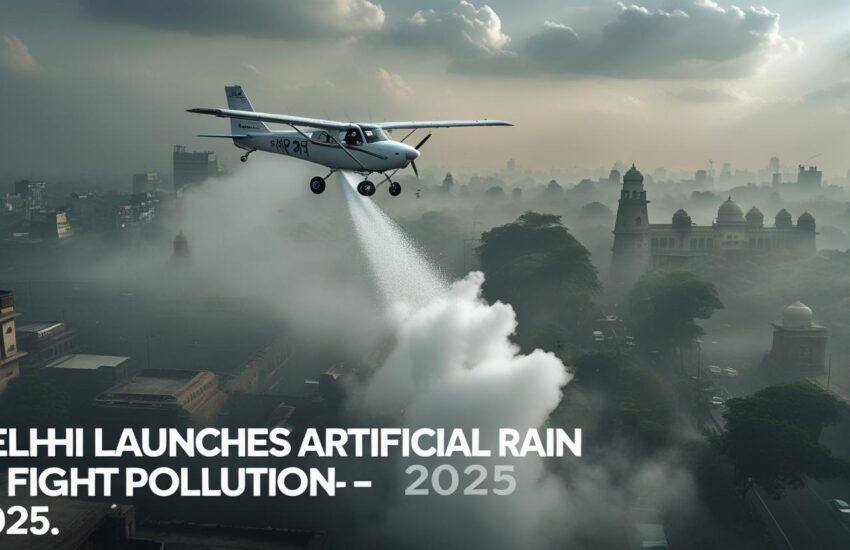Delhi Launches First‑Ever Artificial Rain Trial to Combat Pollution
Harnessing technology and urgency, Delhi is turning to artificial rain, its first cloud‑seeding trial, to deliver immediate relief from toxic smog.
The Smog Crisis Driving Innovation
Delhi’s winters often bring hazardous air quality, with AQI soaring past 400 due to vehicular emissions, nearby crop burning, industrial pollution, and stagnant weather. This pollution poses serious respiratory and cardiovascular risks, with hospitals reporting spikes of 20–30 % in related illnesses post‑Diwali.
To address this, the Delhi government, alongside IIT Kanpur and IMD, is piloting artificial rain in Delhi via cloud‑seeding—flown by Cessna 206‑H aircraft, dispersing silver iodide and salts—to cleanse the air by washing airborne pollutants.
What Is Artificial Rain and How It Works
The Science of Cloud Seeding
Cloud seeding involves introducing cloud condensation nuclei—like silver iodide, potassium iodide, and salt—into clouds to encourage droplet formation. In Delhi’s case, hygroscopic seeding with sodium chloride and silver iodide is used to harness moisture and trigger rainfall.
The Delhi Pilot Plan
Timeline: Initially set for July 4–11, 2025; rescheduled to August 30–September 10 due to monsoon.
Flights: Five sorties over 100 sq km each (~90 min).
Coverage areas: Focus on northwest and outer Delhi (Alipur, Bawana, Rohini, Burari, adjoining UP zones).
Permissions: ₹3.21 cr budget with DGCA, IMD, CPCB, AAI, DGMS, MoD, MoHFW, and SPG clearance.
Benefits of Artificial Rain for Delhi
Pollutant Washout
Rain helps settle PM2.5/PM10, reducing airborne toxins. Cloud‑seeding trials reportedly boost precipitation by 3–15 %—enough to deliver temporary but meaningful air improvements.
Time‑Sensitive Relief
Scheduled before winter smog peaks, the trial’s August‑September window is strategic, allowing data collection to inform possible scale‑up in October–December.
Limitations and Risks
Weather Dependency
Cloud seeding only works with moisture‑rich clouds. Mumbai’s dry winter reduces effectiveness—hence, operations avoid that season due to low humidity and cloud cover.
Temporary Impact & Cost
This ₹3.21 crore effort ($1.5 mn) is costly, and rain effects may not outlast a few days. Without addressing emissions, pollution inevitably returns.
Environmental Concerns
Though silver iodide quantities are low, ecosystem impacts remain under study. Experts call for emission-focused long-term strategies.
How Delhi’s Approach Compares Globally
International Precedents
China (Beijing): Used cloud seeding before the 2008 Olympics.
UAE: Year-round seeding with drone-assisted electric particles; increased rainfall by 10–35 % .
India (Maharashtra): Salt applications over 11 years showed precipitation boosts by ~24 % under ideal conditions.
Scientific Consensus
Studies present mixed results: 3–10 % gains in snow/rain outcomes are common. There’s no guarantee of consistent impact, though some meta‑analyses suggest measurable effects under favourable conditions.
The Road Ahead for Delhi
Data‑Driven Follow‑up
Following trials, AIATPM systems (CAAQMS) will assess real-time changes in PM levels and water chemistry. IIT Kanpur and IMD will evaluate the cost-benefit ratio, success rate, and environmental footprint.
Emergency Pollution Tactic
If statistically effective, cloud seeding could be an emergency tool ahead of high-pollution seasons, used with structural actions like switching to cleaner fuels, green cover, and public transport investment.
Governance & Partnerships
Built on collaboration across government ministries and scientific agencies, the initiative’s efficacy hinges on weather conditions, regulatory support, and public accountability.
About Success Media Market
At Success Media Market, we specialise in crafting data-driven digital campaigns that turn insights into impact:
Explore our SEO services to boost visibility.
Discover our content marketing solutions to engage audiences and convert traffic.
Let us elevate your brand’s message, just like Delhi elevates its air quality ambitions.
📞 Get Started
Don’t let your brand get lost in the pollution.
✨ Book a Free SEO Consultation »
H2: Frequently Asked Questions (FAQ)
Q1: What is “artificial rain in Delhi”?
It refers to cloud‑seeding operations—using aircraft to disperse nucleating agents in clouds to induce localised rainfall over Delhi to wash out pollutants.
Q2: When are the trials happening?
Initially scheduled for July 4–11, 2025, the window shifted to August 30–September 10 to align with cloud availability.
Q3: How effective is cloud seeding?
Global experience shows modest precipitation increases (3–24 %), contingent on cloud quality and moisture.
Q4: Are there risks?
The technique is safe at low chemical concentrations, but cost and scalability remain issues, and it is not a replacement for emission controls.
Q5: Will this solve Delhi’s smog problem?
No—it’s an emergency mitigation step. Long-term air quality improvement hinges on reducing emissions through cleaner technologies, regulation, and public policy.

